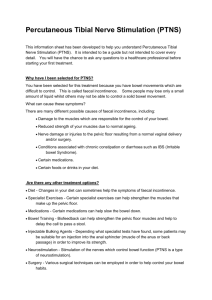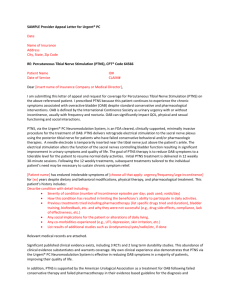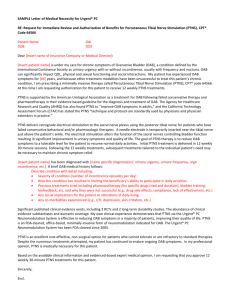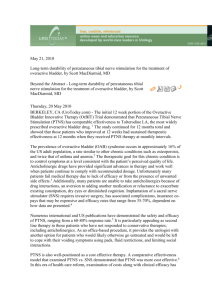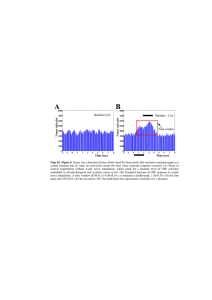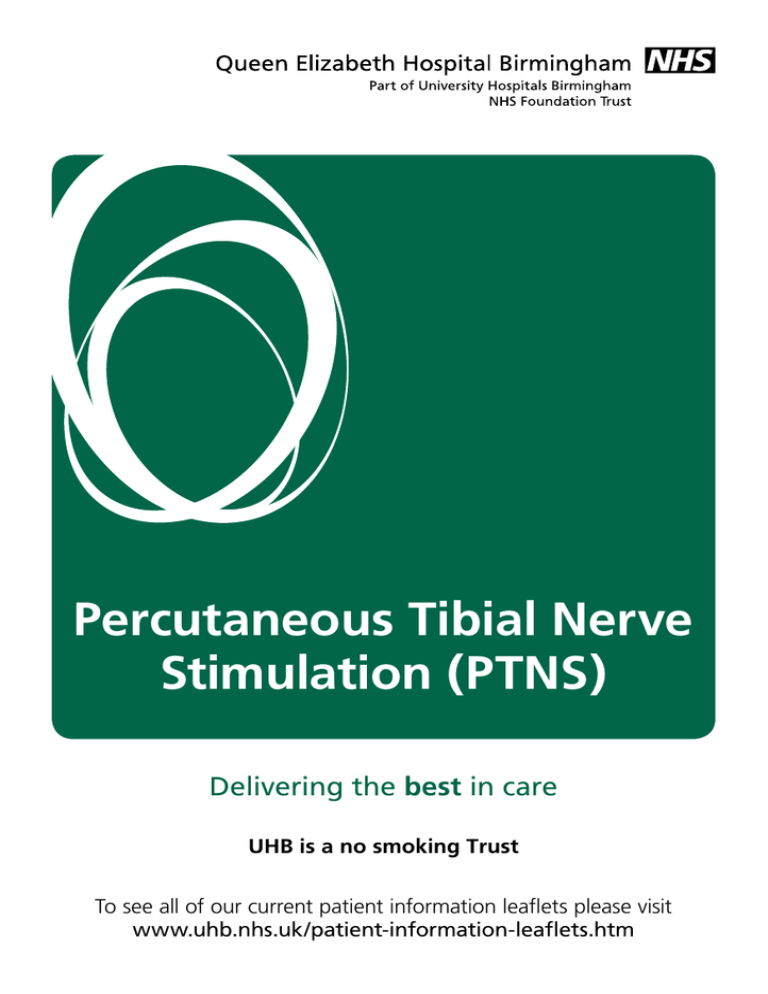
Percutaneous Tibial Nerve
Stimulation (PTNS)
Delivering the best in care
UHB is a no smoking Trust
To see all of our current patient information leaflets please visit
www.uhb.nhs.uk/patient-information-leaflets.htm
Who is it for?
Percutaneous tibial nerve stimulation (PTNS) treatment is used to
treat bowel dysfunction, in particular, faecal incontinence. Faecal
incontinence is when a person loses the ability to control their
bowel movements resulting in leakage of gas or stool. Faecal
incontinence has many different causes. It can be distressing
and can severely affect everyday life. Initial treatment for
faecal incontinence usually includes dietary management and
medication to regulate bowel function. This may be followed
by pelvic floor and anal sphincter muscle training, such as
biofeedback. If conservative management is unsuccessful, PTNS
may be advised.
What is PTNS?
PTNS is a form of treatment which is called neuromodulation.
Bowel function is regulated by a group of nerves at the base
of the spine called the sacral nerve plexus. By stimulating these
nerves through gentle electrical impulses (neurostimulation),
your bowel activity can be changed.
One way to adjust (or enhance) the control of continence is by
PTNS. PTNS is a minimally invasive procedure carried out in an
outpatient setting. PTNS stimulates the nerves in the leg (the
tibial nerves) which in turn stimulate the sacral nerves.
How is it done?
A small, slim needle electrode (like an acupuncture needle) is
temporarily inserted just above your ankle. The needle electrode
is then connected to the battery-powered stimulator. The
stimulator delivers a mild electric current along the needle into
the tibial nerve.
After turning on the stimulator, the clinician observes the
response to determine the ideal strength of the impulses. Each
2 | Percutaneous Tibial Nerve Stimulation
of the treatment sessions will last approximately 40 minutes. The
treatment consists of an initial series of 12 treatments, typically
scheduled a week apart.
After the initial 12 treatments, your clinician will discuss your
response to the treatments and determine if you will need
future treatments to maintain your results.
What does it feel like?
It’s difficult to say as people respond in different ways, but most
patients feel a buzzing, tingling or throbbing sensation while the
stimulation is occurring.
Once the correct feeling is located the current can be turned
down so that it is comfortable – it is not necessary to feel this
throbbing sensation for the whole 30 minutes.
What are the results?
This is a relatively new treatment but the published studies have
shown that 3 out of 4 people had a reduction in their faecal
incontinence after treatment.
It usually takes between 6 and 10 treatments before any change
in symptoms is apparent. It is very important that there is no gap
in the twelve-week treatment programme as this can affect the
success of the treatment.
Most patients have to return for booster treatments as the
effects of PTNS start to wear off after 4-6 months.
As it is a relatively new treatment it is not known how effective
it is long term.
Percutaneous Tibial Nerve Stimulation | 3
What are the risks?
PTNS is a very safe procedure.
Treatment with the ‘Urgent PC Neuromodulation System’ for
PTNS should not be used for:
• Individuals with pacemakers or implantable defibrillators
• Individuals prone to excessive bleeding
• Individuals with nerve damage that could impact either
percutaneous tibial nerve or pelvic floor function.
• Women who are pregnant or planning to become pregnant
during the duration of the treatment
Potential side effects associated with PTNS treatments include:
• Discomfort and pain (including throbbing pain) near the
stimulation site
• Redness and inflammation at or near the stimulation site
• Bruising at the stimulation site
• Toe numbness
• Stomach ache
There are currently no recorded serious side effects.
What are the benefits?
This is a minimally invasive treatment which improves the
symptoms of bowel leakage and urgency in three quarters of the
patients who have it.
What are the alternatives?
The other method of neuromodulation is to surgically implant
a stimulator in the buttocks which sends continuous impulses
to the sacral nerve plexus. This involves surgery and having a
permanent implant in the body and so involves more risks and
side effects.
4 | Percutaneous Tibial Nerve Stimulation
How is the treatment done?
©Uroplasty, Inc. All rights reserved
Treatment set-up
You will be asked to sit in a chair or on a couch with your
treatment leg elevated. Your clinician will:
• Clean your ankle and arch on the treatment leg
• Insert a thin needle electrode above your ankle
• Attach a sticky pad to the arch of your foot
• Connect the components to the stimulator
• You will remain comfortably seated for the 30 minute treatment
To determine the optimal treatment settings
• Your clinician will turn on the stimulator and adjust the setting
• You will feel a sensation in your ankle or foot
• Your toes may also spread out and curl
Let your clinician know if the sensation is too strong or if your
sitting position is uncomfortable.
Percutaneous Tibial Nerve Stimulation | 5
Receiving treatment
The stimulator will deliver 30 minutes of therapy.
You can read, or do crossword puzzles or other similar activities
during your treatment.
After treatment
The stimulator will beep upon the completion of the treatment
session. Your clinician will turn off the stimulator and remove the
needle electrode. You should be able to resume normal activities
immediately following treatment.
Treatment schedule
You will have an initial series of 12 weekly sessions lasting for
approximately 30 minutes each.
As this is a relatively new treatment it is important to collect as
much information about your problem both before and after
the treatment You will be asked to fill in assessments about your
symptoms and the affect they have on your life. You should
report any side effects you experience. This is important as it is a
new treatment.
You may need to return periodically to maintain your improved
continence for further treatments (this is usually every 4-6 months).
It is very important to the success of the treatment that there
are no long breaks during the initial 12 weeks of treatment.
If you have a holiday planned it is best to delay the start of
treatment until after the holiday. It is also possible to have the
treatment twice a week, so only having to attend for 6 weeks.
Please discuss any problems about appointments with your clinician.
If you have any further questions, please do not
hesitate to ask
6 | Percutaneous Tibial Nerve Stimulation
Contact details
Colorectal clinical nurse specialists
Telephone: 0121 371 4980
Telephone: 0121 371 4501 (answerphone)
Useful contacts
Bladder and Bowel Foundation
Helpline: 0845 345 0165
www.bladderandbowelfoundation.org
Core
Telephone: 0207 486 0341
www.corecharity.org.uk
Percutaneous Tibial Nerve Stimulation | 7
We would like to thank Urolplasty, Inc. for kindly granting us permission
to use the illustration contained in this leaflet.
The Trust provides free monthly health talks on a
variety of medical conditions and treatments. For more
information visit www.uhb.nhs.uk/health-talks.htm or
call 0121 371 4323.
Functional Bowel Disease Service
Queen Elizabeth Hospital Birmingham
Mindelsohn Way, Edgbaston,
Birmingham, B15 2GW
Telephone: 0121 371 4980
PI14/1445/01 Author: Yvette Perston
Date: February 2015 Review date: February 2017

